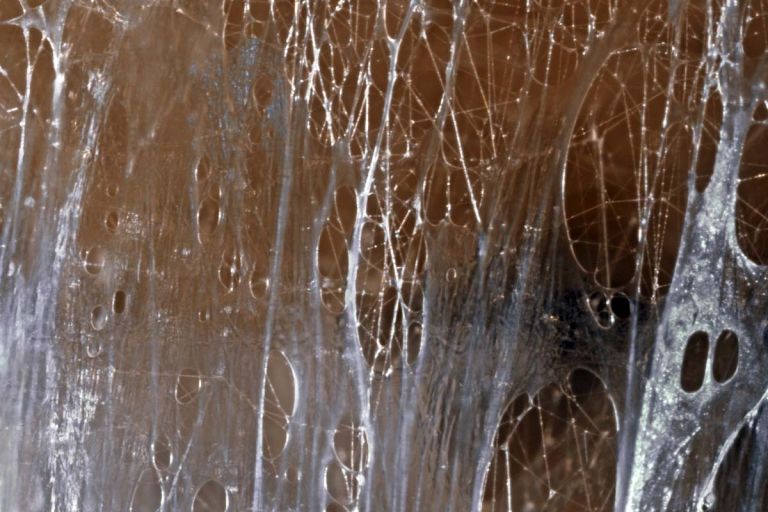
What are fasciae? Explained simply and understandably.

You have probably heard about fascia, this fascinating connective tissue. People have been talking and reporting about it for some time now. But you still don't really know how this tissue is structured and what important functions it has? We bring you closer to the fascination of fasciae - in a simple and understandable way.
One thing is clear: fasciae play an important role in your health and well-being. They connect all structures with each other and form a huge network that runs from the surface to the depths of your entire body. This is how they hold your body together and all your organs in place. According to the renowned fascia researcher Robert Schleip, the average weight of fascia in humans is 18 to 23 kilograms.
01. How it started with the fasciae
For a long time, science and medicine did not attach much importance to fasciae. They were regarded as irrelevant body-enveloping tissue. Only isolated naturopathic forms of therapy, such as osteopathy, made use of fasciae in their treatment successes, without being aware of the exact structure. In most anatomical examinations, the fasciae were simply removed in order to reach the organs, bones, nerves and vessels that were more interesting further down at the time.
It was only a few years ago that this changed. Scientists became more and more involved with the fasciae and thus learned about their special significance. In 2007, the first "Fascia Research Congress" took place in Boston, where experts from all over the world exchanged their discoveries for the first time. From Germany, Robert Schleip is one of the leading fascia experts.
Even though fasciae have not yet been researched in depth, they are considered a very important structure of the body. They have many functions and can be the cause of pain and functional disorders.
02. Fascia simply explained
The term fascia is derived from the Latin word "fascia", which translated means band, bundle, band-aid or bandage.
Fasciae run through the entire human body down to the deepest regions. They are considered to be an enveloping and connecting, finely meshed as well as tough three-dimensional meshwork. All fasciae are interconnected in some way.
For example, fasciae stabilise the body in static holding positions and dynamic movements against gravity - whether standing, sitting or lying down. They maintain their shape at all times and keep all organs in place.
This can be explained using the tensegrity model from architecture. In this model, solid elements are held together and stabilised purely by the balance of tension forces. In the example of the body, the solid elements represent the bones, which virtually float freely in the fascial network under tension.
03. Fascia - a special connective tissue
The anatomy of fascia is similar to that of other connective tissue. Fascia is basically made up of cells and what surrounds them, the extracellular matrix. In its physiological state, the extracellular matrix binds a lot of fluid, which is very important for its main function in the muscle, mobility. This keeps the muscle tissue supple and allows the individual muscle fibres to slide easily past each other.
The fascia consists mainly of two types of proteins: collagen fibres are 2-20 µm thick and give the tissue a high tensile strength. They are virtually impossible to stretch. Elastic fibres, on the other hand, are only about 2 µm thick and have strong extensibility. They can reach up to twice their length. Depending on the mixture, this gives the fascia tissue greater stability or greater flexibility.
The entire fascia can be up to 3 millimetres thick, for example the fascia throacolumbalis in the back region or the tractus iliotibialis on the outer thigh. The latter is a kind of reinforcement of the lateral thigh fascia, the fascia lata.
04. The 3 fascia layers
The fasciae of the body are divided into three layers - the superficial, deep and visceral layer.
Superficial layer
The superficial fascia layer is located just under the skin and consists of a dense network of elastic fibres. This makes it very stretchable, as is necessary, for example, when gaining weight or during pregnancy. The superficial layer surrounds the entire body and thus serves as a kind of "communication system". It is permeated by lymph and blood vessels as well as nerve pathways and glands. It also has a certain buffering and cushioning function.
Deep layer
The deep fascia layer surrounds and penetrates muscles, tendons, ligaments, bones, joints, nerve pathways and blood vessels. It has a high content of collagen fibres. This means that compared to the superficial layer, it is particularly stable in tension and has low stretching capacity.
The individual fasciae, such as those of the muscles, have separate names:
- Epimysium: Envelops the entire muscle
- Perimysium: Envelops individual muscle fibre bundles
- Endomysium: Envelops individual muscle fibres
The deep layer has many receptors that are specialised for certain stimuli. And significantly more than the muscles, for example. This makes the fascial network the largest sensory organ in humans.
Visceral layer
The visceral fascia layer serves to suspend and embed internal organs. Like the deep layer, it is also less stretchable than the superficial layer, because in order to stabilise the organs, their tension must remain almost constant. The visceral layer encloses, for example, the brain and spinal cord with the meninges, the heart with the pericardium and the lungs with the pleura.
05. Fascia as a sensory organ
Fasciae contain an extremely high number of receptors that pick up different information and transmit it to the central nervous system. Before this realisation, the skin was called the largest sensory organ in humans. Now experts attribute this to the network of fasciae.
The different receptors have separate names because of their specialisation:
- Nociceptors: they register potential or actual tissue damage. Depending on several factors, pain is perceived through their activation in the brain.
- Proprioceptors: They help in the perception and coordination of conscious and unconscious body positions and movements.
- Mechanoreceptors: They perceive, for example, pressure, tension and vibration stimuli.
- Chemoreceptors: They detect changes in the chemical environment, as is the case with inflammation, for example.
Fasciae are said to have an emotional memory function. This means that they can store experiences - and that includes pain. As a result, the fascia can shorten and stick together.
06. Fascia - like a muscle
Similar to a muscle, fasciae of the deep layer can actively contract. They receive this special function through small star-shaped cells, the myofibroblasts.
This is important, among other things, to maintain body stability in the long term. However, if this increase in tension occurs constantly over days to months, the fascia tissue changes. This can lead to a general increase in tissue stiffness and, for example, significantly affect joint mobility. Persistent mental stress, constant overstrain or diet can be causes for this, for example.
Fascia - like a tendon
Similar to tendons, fasciae have the function of storing and releasing energy in the short term. Strictly speaking, tendons are now even counted as fasciae. They act like a spring system that helps to perform certain activities such as jumping and sprinting more economically - that means with less effort from the muscles. In kangaroos, for example, this means that they can jump higher and further than would be possible with their muscles alone. In addition, fasciae are involved in the transmission of force from the muscles to the bones.











